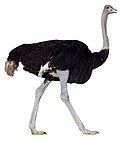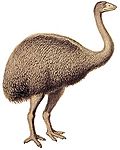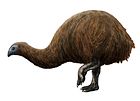Mullerornis
| Mullerornis Temporal range:
| |
|---|---|

| |
| Life restoration | |
| Scientific classification | |
| Domain: | Eukaryota |
| Kingdom: | Animalia |
| Phylum: | Chordata |
| Class: | Aves |
| Infraclass: | Palaeognathae |
| Order: | †Aepyornithiformes |
| Genus: | †Mullerornis Milne-Edwards & Grandidier 1894 |
| Type species | |
| Mullerornis betsilei Milne-Edwards & Grandidier 1894
| |
| Species | |
| |

| |
| Map of Madagascar showing where specimens have been found | |
| Synonyms | |
| |
Mullerornis modestus is an extinct species of elephant bird, and the only member of the genus Mullerornis.
Taxonomy
[edit]The genus is named after Georges Muller, a French explorer, who was killed in 1892 by hostile members of the Sakalava people.
Synonyms of Mullerornis modestus
[edit]- Mullerornis betsilei Milne-Edwards & Grandidier, 1894[2] (Betsileo elephant bird)
- Mullerornis agilis Milne-Edwards & Grandidier, 1894 (agile/coastal elephant bird)
- Mullerornis rudis Milne-Edwards & Grandidier, 1894[1] (robust elephant bird)
- ?Mullerornis grandis Lamberton 1934 (holotype destroyed in a fire in 1995)
Description
[edit]
Mullerornis is smaller than the more well-known Aepyornis,[3][4] with a still substantial body mass of approximately 80 kilograms (180 lb).[5] A bone possibly belonging to Mullerornis has been radiocarbon dated to about 1260 BP,[6] suggesting that the animal was still extant at the end of the first millennium.[7] Aepyornis modestus was shown by Hansford and Turvey (2018) to be a senior synonym of all nominal Mullerornis species described by Milne-Edwards and Grandidier (1894), resulting in the new combination Mullerornis modestus.[8]
Palaeobiology
[edit]Nocturnality
[edit]Like other elephant birds and its kiwi relatives, Mullerornis probably was nocturnal based on the small size of its optic lobes, though it shows less optical lobe reduction than these other taxa, implying slightly more crepuscular habits.[9]
Diet
[edit]Isotopic evidence suggests that Mullerornis was likely a browsing herbivore.[10]
Reproduction
[edit]The eggs of Mullerornis are substantially smaller than those of Aepyornis, weighting approximately 0.86 kilograms (1.9 lb), with a shell thickness of about 1.1 mm (3⁄64 in).[5]
Footnotes
[edit]- ^ a b Davies, S. J. J. F. (2003)
- ^ Julian P. Hume; Michael Walters (2012). Extinct birds. T&AD Poyser. p. 544. ISBN 978-1408158616.
- ^ Burney, et al. (1997), p. 763
- ^ MacPhee, et al. (1985), table II
- ^ Burney, et al. (2004), p. 50
- ^ Burney et al. (2004), p. 25
- ^ Hansford, J. P.; Turvey, S. T. (2018-09-26). "Unexpected diversity within the extinct elephant birds (Aves: Aepyornithidae) and a new identity for the world's largest bird". Royal Society Open Science. 5 (9): 181295. doi:10.1098/rsos.181295.
- ^ Christopher R. Torres & Julia A. Clarke. 2018. Nocturnal giants: evolution of the sensory ecology in elephant birds and other palaeognaths inferred from digital brain reconstructions. Proc. R. Soc. B 285 (1890); doi: 10.1098/rspb.2018.1540
- ^ Hansford, James P.; Turvey, Samuel T. (April 2022). "Dietary isotopes of Madagascar's extinct megafauna reveal Holocene browsing and grazing guilds". Biology Letters. 18 (4): 20220094. doi:10.1098/rsbl.2022.0094. ISSN 1744-957X. PMC 9006009. PMID 35414222.
References
[edit]- Burney, David A.; James, Helen F.; Grady, Frederick V.; Rafamantanantsoa, Jean-Gervais; Ramilisonina; Wright, Henry T.; Cowart, James B. (1997). "Environmental change, extinction and human activity: Evidence from caves in NW Madagascar" (PDF). Journal of Biogeography. 24 (6): 755–767. Bibcode:1997JBiog..24..755B. doi:10.1046/j.1365-2699.1997.00146.x. hdl:2027.42/75139.
- Burney, David A.; Burney, Lida Pigott; Godfrey, Laurie R.; Jungers, William L.; Goodman, Steven M.; Wright, Henry T.; Jull, A. J. Timothy (2004). "A chronology for late prehistoric Madagascar". Journal of Human Evolution. 47 (1–2): 25–63. Bibcode:2004JHumE..47...25B. doi:10.1016/j.jhevol.2004.05.005. PMID 15288523.
- Davies, S. J. J. F. (2003). "Elephant birds". In Hutchins, Michael (ed.). Grzimek's Animal Life Encyclopedia. Vol. 8 Birds I Tinamous and Ratites to Hoatzins (2 ed.). Farmington Hills, MI: Gale Group. pp. 103–104. ISBN 0-7876-5784-0.
- MacPhee, R. D. E.; Burney, David A.; Wells, N. A. (1985). "Early Holocene chronology and environment of Ampasambazimba, a Malagasy subfossil lemur site". International Journal of Primatology. 6 (5): 463–489. doi:10.1007/BF02735571. S2CID 44449535.



